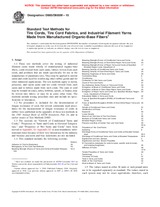Potrebujeme váš súhlas na využitie jednotlivých dát, aby sa vám okrem iného mohli ukazovať informácie týkajúce sa vašich záujmov. Súhlas udelíte kliknutím na tlačidlo „OK“.
ASTM D885/D885M-10
Standard Test Methods for Tire Cords, Tire Cord Fabrics, and Industrial Filament Yarns Made from Manufactured Organic-Base Fibers
Automaticky preložený názov:
Štandardné testovacie metódy pre kordov , Tire kordových tkanín a priemyselné historky vlákna vyrobené zo spracovateľského Organic - Base vlákna
NORMA vydaná dňa 1.1.2010
Informácie o norme:
Označenie normy: ASTM D885/D885M-10
Poznámka: NEPLATNÁ
Dátum vydania normy: 1.1.2010
Kód tovaru: NS-39610
Počet strán: 31
Približná hmotnosť: 93 g (0.21 libier)
Krajina: Americká technická norma
Kategória: Technické normy ASTM
Anotácia textu normy ASTM D885/D885M-10 :
Keywords:
commercial mass, dip pickup, industrial yarn, linear density, manufactured fibers, moisture regain, shrinkage, tensile properties/tests, tire cord, tire fabric, twist, Breaking strength/tenacity--textile fabrics/fibers, Commercial mass, Density--linear, Diameter--textile fabrics/fibers, Dip pickup (DPU), Elongation--textiles, Man-made textile fibers, Mass--commercial mass, Modulus, Moisture analysis--textile fabrics/fibers, Polyester plastics, Rubber adhesion, Shrinkage--textile fabrics/fibers
Doplňujúce informácie
| Significance and Use | ||||||||||||||||||||||||||||||||||||||||
|
The procedures in these test methods should be used with caution for acceptance of commercial shipments owing to the absence of factual information on the between-laboratory precision of many of the test procedures included in these test methods. It is recommended that any program of acceptance testing be preceded by an interlaboratory check in the laboratory of the purchaser and the laboratory of the supplier on replicate specimens of the materials to be tested for each property (or properties) to be evaluated. If there are differences of practical significance between reported test results for two laboratories (or more), comparative tests should be performed to determine if there is a statistical bias between them, using competent statistical assistance. As a minimum, test samples should be used that are as homogeneous as possible, that are drawn from the material from which the disparate test results were obtained, and that are randomly assigned in equal numbers to each laboratory for testing. Other materials with established test values may be used for this purpose. The test results from the two laboratories should be compared using a statistical test for unpaired data, at a probability level chosen prior to the testing series. If a bias is found, either its cause must be found and corrected, or future test results must be adjusted in consideration of the known bias. The significance and use of particular properties are discussed in the appropriate sections of specific test methods. |
||||||||||||||||||||||||||||||||||||||||
| 1. Scope | ||||||||||||||||||||||||||||||||||||||||
|
1.1 These test methods cover the testing of industrial filament yarns made wholly of manufactured organic-base fibers, cords twisted from such yarns, fabrics woven from such cords, and products that are made specifically for use in the manufacture of pneumatic tires. They may be applied to similar yarns and cords used for reinforcing other rubber goods and for other industrial applications. The test methods apply to nylon, polyester, and rayon yarns and tire cords twisted from such yarns and to fabrics made from such cords. The yarn or cord may be wound on cones, tubes, bobbins, spools, or beams; may be woven into fabric; or may be in some other form. The methods include testing procedure only and include no specifications or tolerances. 1.2 No procedure is included for the determination of fatigue resistance of cord, but several commonly used procedures for the measurement of fatigue resistance of cords in rubber were published in the appendix of these test methods in the 1967 Annual Book of ASTM Standards, Part 24, and in earlier issues of Test Methods D885. 1.3 The sections on “Growth of Conditioned Yarns and Cords,” “Properties of Yarns and Cords at Elevated Temperature,” and “Properties of Wet Yarns and Cords” have been moved to Appendix X1-Appendix X3 as non-mandatory informational items because of their very limited use by the industry and because precision and bias statements are not included. |
||||||||||||||||||||||||||||||||||||||||
| 2. Referenced Documents | ||||||||||||||||||||||||||||||||||||||||
|
Odporúčame:
Aktualizácia technických noriem
Chcete mať istotu, že používate len platné technické normy?
Ponúkame Vám riešenie, ktoré Vám zaistí mesačný prehľad o aktuálnosti noriem, ktoré používate.
Chcete vedieť viac informácií ? Pozrite sa na túto stránku.




 Cookies
Cookies
